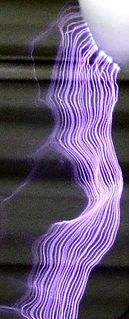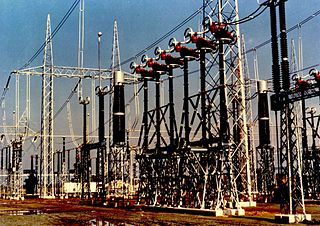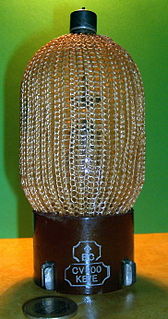
An electrical insulator is a material in which electric current does not flow freely. The atoms of the insulator have tightly bound electrons which cannot readily move. Other materials, semiconductors and conductors conduct electric current more easily. The property that distinguishes an insulator is its resistivity; insulators have higher resistivity than semiconductors or conductors. The most common examples are non-metals.
In physics, the term dielectric strength has the following meanings:
In electrical engineering, partial discharge (PD) is a localized dielectric breakdown (DB) of a small portion of a solid or fluid electrical insulation (EI) system under high voltage (HV) stress. While a corona discharge (CD) is usually revealed by a relatively steady glow or brush discharge (BD) in air, partial discharges within solid insulation system are not visible.

A Lichtenberg figure, or Lichtenberg dust figure, is a branching electric discharge that sometimes appears on the surface or in the interior of insulating materials. Lichtenberg figures are often associated with the progressive deterioration of high voltage components and equipment. The study of planar Lichtenberg figures along insulating surfaces and 3D electrical trees within insulating materials often provides engineers with valuable insights for improving the long-term reliability of high-voltage equipment. Lichtenberg figures are now known to occur on or within solids, liquids, and gases during electrical breakdown.

Electrical breakdown or dielectric breakdown is a process that occurs when an electrical insulating material, subjected to a high enough voltage, suddenly becomes an electrical conductor and electric current flows through it. All insulating materials undergo breakdown when the electric field caused by an applied voltage exceeds the material's dielectric strength. The voltage at which a given insulating object becomes conductive is called its breakdown voltage and depends on its size and shape. Under sufficient electrical potential, electrical breakdown can occur within solids, liquids, gases or vacuum. However, the specific breakdown mechanisms are different for each kind of dielectric medium.

High voltage electricity refers to electrical potential large enough to cause injury or damage. In certain industries, high voltage refers to voltage above a certain threshold. Equipment and conductors that carry high voltage warrant special safety requirements and procedures.

The breakdown voltage of an insulator is the minimum voltage that causes a portion of an insulator to become electrically conductive.

An electric arc, or arc discharge, is an electrical breakdown of a gas that produces a prolonged electrical discharge. The current through a normally nonconductive medium such as air produces a plasma; the plasma may produce visible light. An arc discharge is characterized by a lower voltage than a glow discharge and relies on thermionic emission of electrons from the electrodes supporting the arc. An archaic term is voltaic arc, as used in the phrase "voltaic arc lamp".

In an electric power system, switchgear is composed of electrical disconnect switches, fuses or circuit breakers used to control, protect and isolate electrical equipment. Switchgear is used both to de-energize equipment to allow work to be done and to clear faults downstream. This type of equipment is directly linked to the reliability of the electricity supply.
Transformer oil or insulating oil is an oil that is stable at high temperatures and has excellent electrical insulating properties. It is used in oil-filled transformers, some types of high-voltage capacitors, fluorescent lamp ballasts, and some types of high-voltage switches and circuit breakers. Its functions are to insulate, suppress corona discharge and arcing, and to serve as a coolant.

A trigatron is a type of triggerable spark gap switch designed for high current and high voltage,. It has very simple construction and in many cases is the lowest cost high energy switching option. It may operate in open air, it may be sealed, or it may be filled with a dielectric gas other than air or a liquid dielectric. The dielectric gas may be pressurized, or a liquid dielectric may be substituted to further extend the operating voltage. Trigatrons may be rated for repeated use, or they may be single-shot, destroyed in a single use.

In electrical engineering, treeing is an electrical pre-breakdown phenomenon in solid insulation. It is a damaging process due to partial discharges and progresses through the stressed dielectric insulation, in a path resembling the branches of a tree. Treeing of solid high-voltage cable insulation is a common breakdown mechanism and source of electrical faults in underground power cables.
Dissolved gas analysis (DGA) is an examination of electrical transformer oil contaminants. Insulating materials within electrical equipment liberate gases as they slowly break down over time. The composition and distribution of these dissolved gases are indicators of the effects of deterioration, such as pyrolysis or partial discharge, and the rate of gas generation indicates the severity. DGA is beneficial to a preventive maintenance program.
Electrical insulation papers are paper types that are used as electrical insulation in many applications due to pure cellulose having outstanding electrical properties. Cellulose is a good insulator and is also polar, having a dielectric constant significantly greater than one. Electrical paper products are classified by their thickness, with tissue considered papers less than 1.5 mils (0.0381 mm) thickness, and board considered more than 20 mils (0.508 mm) thickness.

A high-voltage cable is a cable used for electric power transmission at high voltage. A cable includes a conductor and insulation. Cables are considered to be fully insulated. This means that they have a full rated insulation system which will consist of insulation, semi-con layers, and a metallic shield. This is in contrast to an overhead line, which may include insulation but not fully rated for operating voltage. High-voltage cables of differing types have a variety of applications in instruments, ignition systems, and alternating current (AC) and direct current (DC) power transmission. In all applications, the insulation of the cable must not deteriorate due to the high-voltage stress, ozone produced by electric discharges in air, or tracking. The cable system must prevent contact of the high-voltage conductor with other objects or persons, and must contain and control leakage current. Cable joints and terminals must be designed to control the high-voltage stress to prevent breakdown of the insulation.
A liquid dielectric is a dielectric material in liquid state. Its main purpose is to prevent or rapidly quench electric discharges. Dielectric liquids are used as electrical insulators in high voltage applications, e.g. transformers, capacitors, high voltage cables, and switchgear. Its function is to provide electrical insulation, suppress corona and arcing, and to serve as a coolant.

Film capacitors, plastic film capacitors, film dielectric capacitors, or polymer film capacitors, generically called "film caps" as well as power film capacitors, are electrical capacitors with an insulating plastic film as the dielectric, sometimes combined with paper as carrier of the electrodes.

A dielectric withstand test is an electrical test performed on a component or product to determine the effectiveness of its insulation. The test may be between mutually insulated sections of a part or energized parts and electrical ground. The test is a means to qualify a device's ability to operate safely during rated electrical conditions. If the current through a device under test is less than a specified limit at the required test potential and time duration, the device meets the dielectric withstand requirement. A dielectric withstand test may be done as a factory test on new equipment, or may be done on apparatus already in service as a routine maintenance test.
Condition monitoring of transformers is the process of acquisition and processing of data related to various parameters of transformers so as to predict and prevent the failure of a transformer. This is done by observing the deviation of the transformer parameters from their expected values. Transformers are the most critical assets of electrical transmission and distribution system. Transformer failures could cause power outages, personal and environmental hazards and expensive rerouting or purchase of power from other suppliers. Transformer failures can occur due to various causes. Transformer in-service interruptions and failures usually result from dielectric breakdown, winding distortion caused by short circuit withstand, winding and magnetic circuit hot spot, electrical disturbances, deterioration of insulation, lightning, inadequate maintenance, loose connections, overloading, failure of accessories such as OLTCs, bushings, etc. Integrating the ‘individual cause’ monitoring allows for monitoring the overall condition of transformer. The important aspects of condition monitoring of transformers are:













